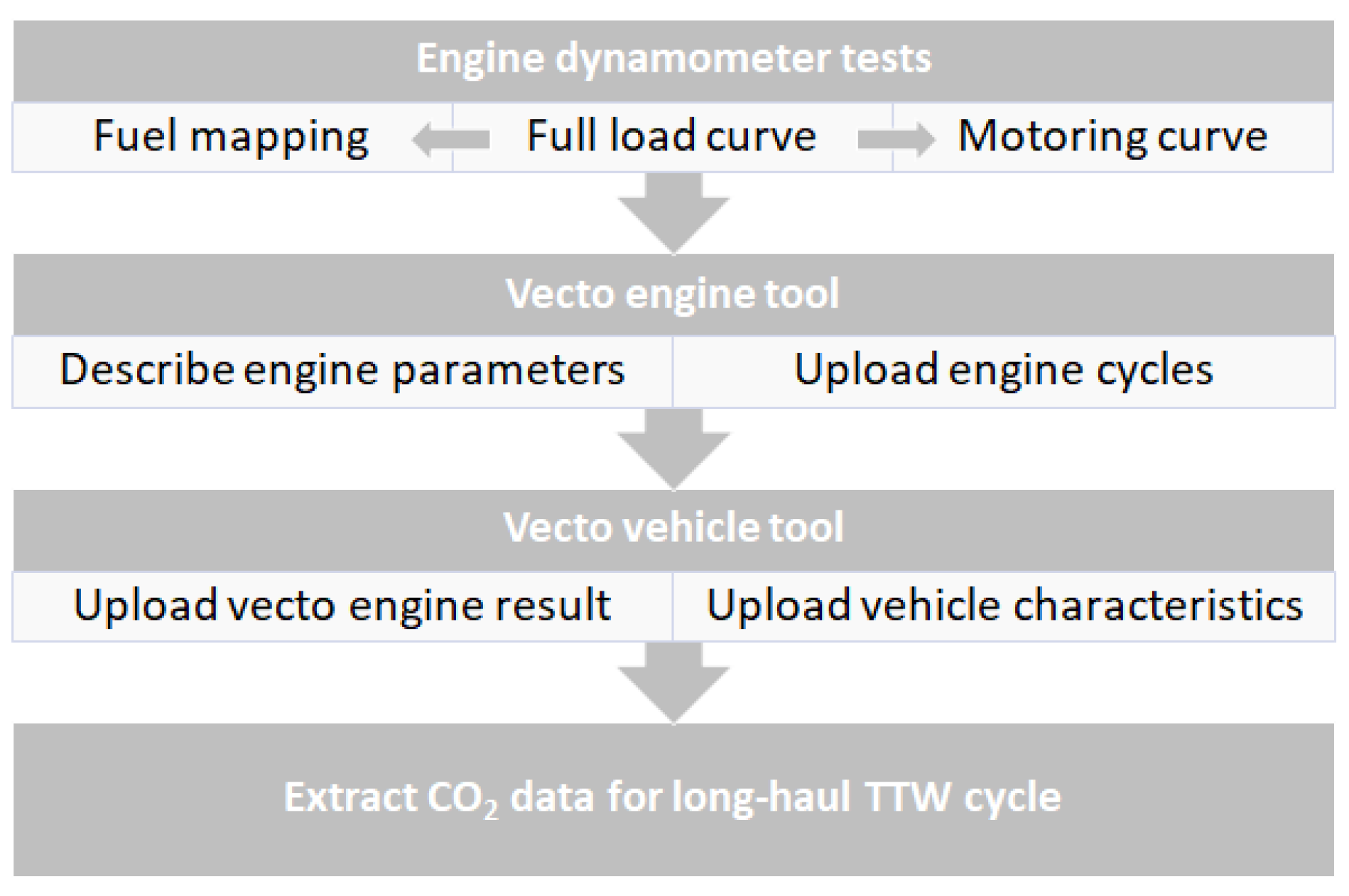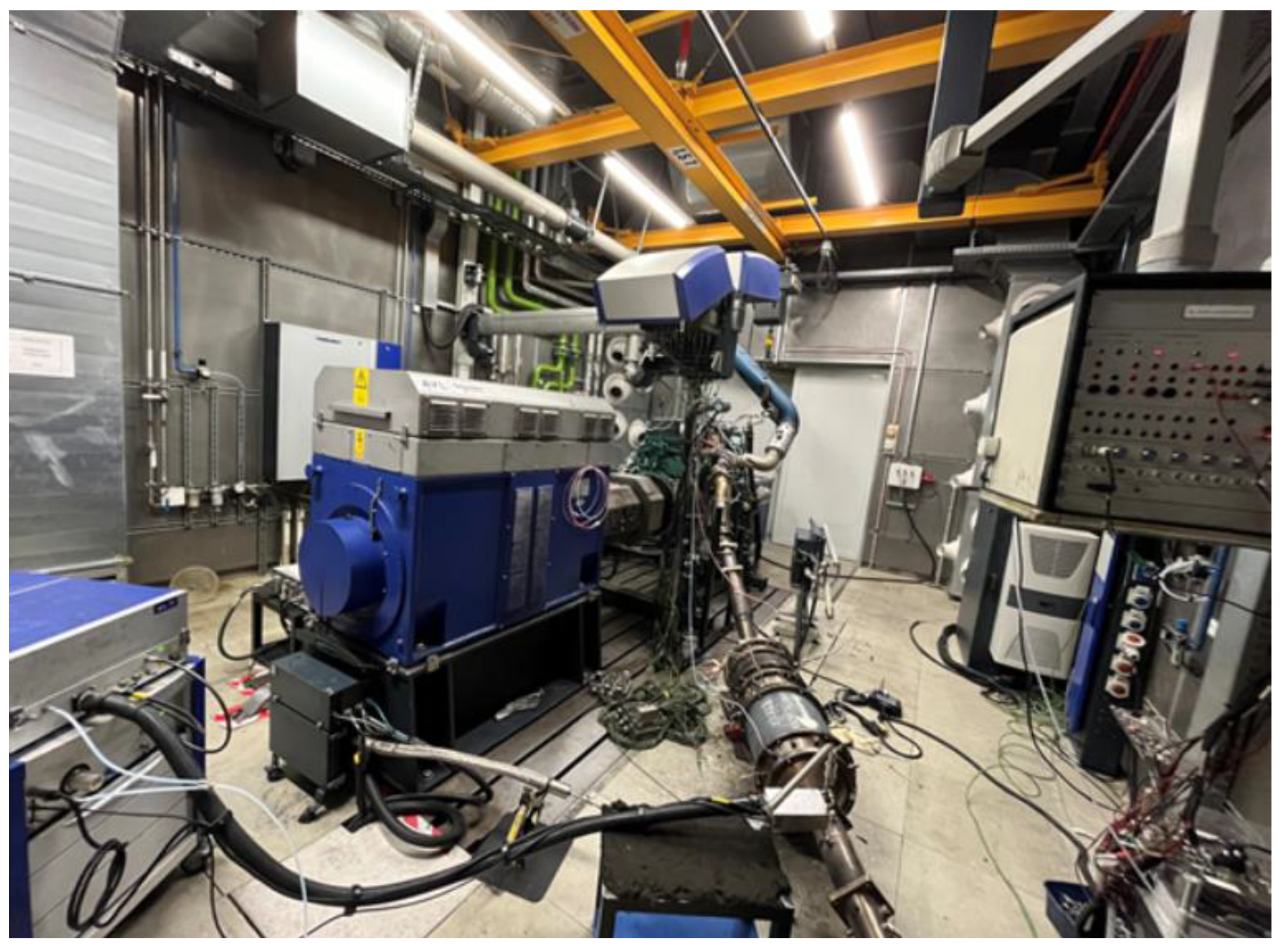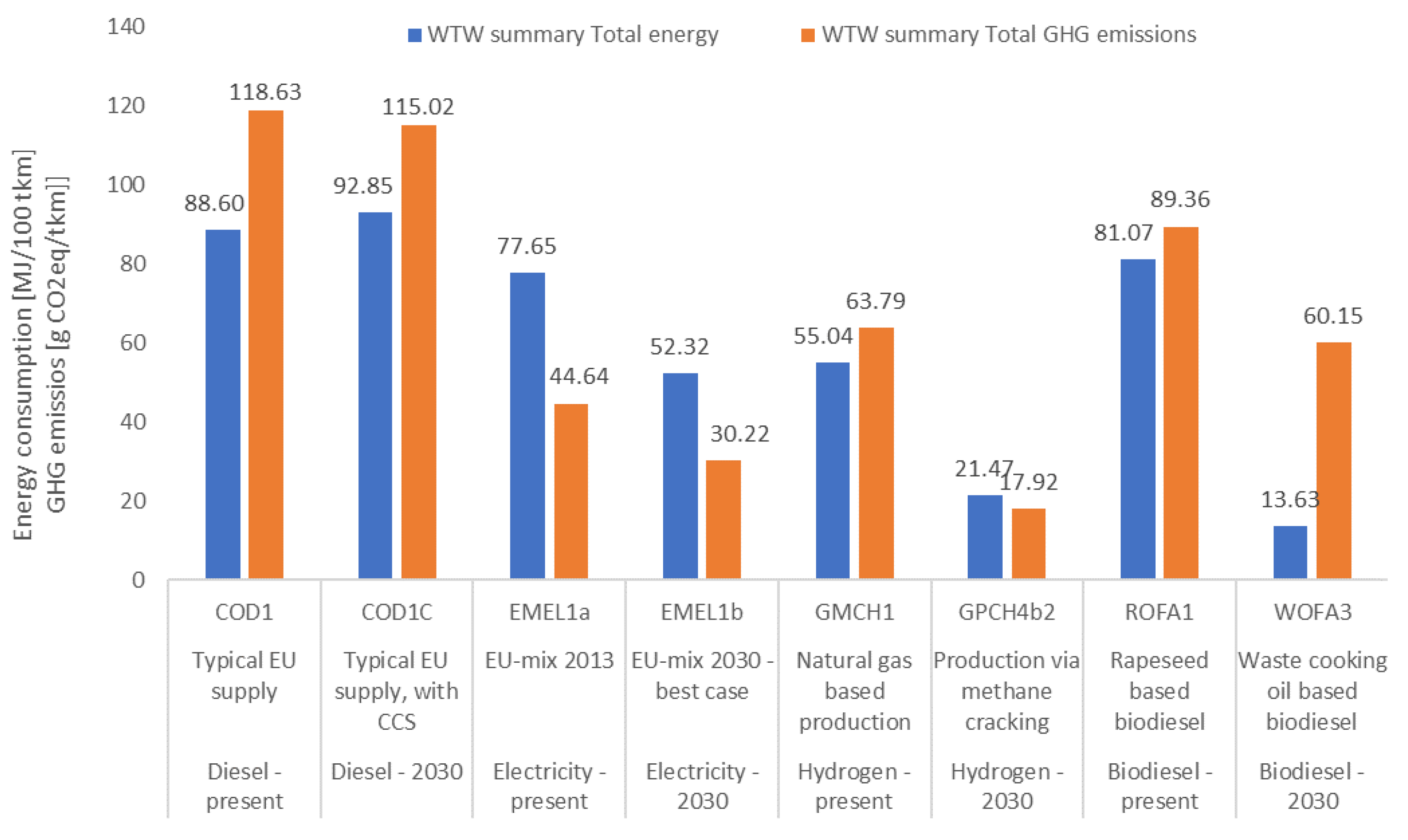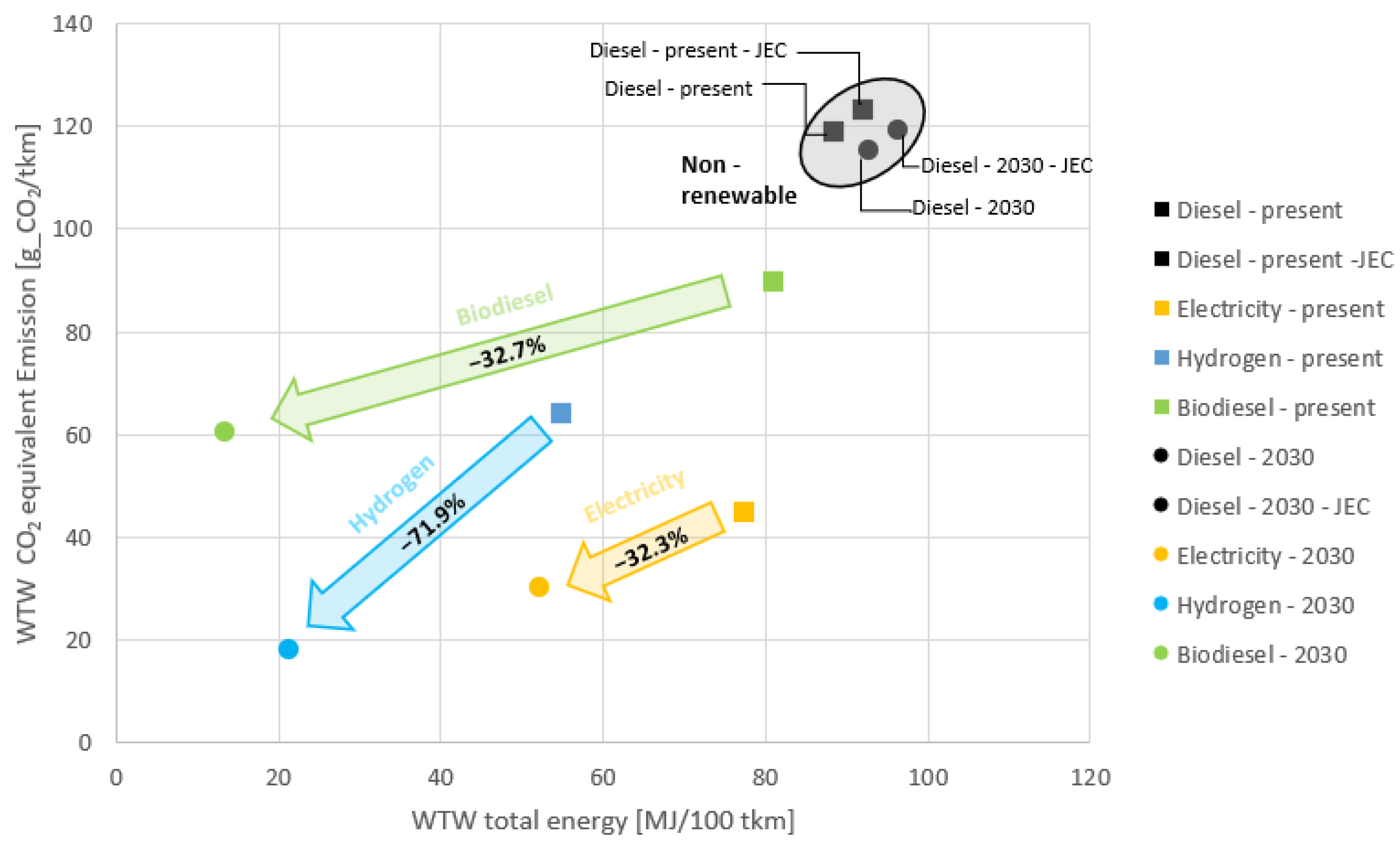Emission Quantification for Sustainable Heavy-Duty Transportation
Abstract
1. Introduction
1.1. Research Hypothesis
1.2. Explaining Greenhouse Gases
- Carbon-dioxide (CO2) = 1 [CO2-equivalent],
- Methane (CH4) = 25 [CO2-equivalent],
- Nitrous oxide (N2O) = 298 [CO2-equivalent],
- Sulphur hexafluoride (SF6) = 22,800 [CO2-equivalent],
2. Materials and Methods
2.1. Overview of Methods
2.2. Well-to-Tank Evaluation
- Production and conditioning at the source (All operations linked to the extraction of the primary energy source)
- Transformation at source (First stage refinery of the primary energy source)
- Transportation to the EU (Crude or first-stage refined energy carrier transportation)
- Transformation in the EU (Refining process for market requirements)
- Conditioning and distribution (Final refinery stage of fuels and distribution for individual refueling points
2.3. Tank to Wheel Evaluation
2.3.1. Engine Dynamometer Test
2.3.2. Vecto Engine Evaluation
2.3.3. Vecto Vehicle Evaluation
3. Results
3.1. Result Overview
| Fuel | WTW Summary | |||
|---|---|---|---|---|
| Type | Description | Code | Total Energy | Total GHG Emissions |
| Diesel | Typical EU supply | COD1 | 88.60 | 118.63 |
| Diesel | Typical EU supply, with CCS | COD1C | 92.85 | 115.02 |
| Electricity | EU-mix 2013 | EMEL1a | 77.65 | 44.64 |
| Electricity | EU-mix 2030 - best case | EMEL1b | 52.32 | 30.22 |
| Hydrogen | Natural gas based production | GMCH1 | 55.04 | 63.79 |
| Hydrogen | Production via methane cracking | GPCH4b2 | 21.47 | 17.92 |
| Biodiesel | Rapeseed based biodiesel | ROFA1 | 81.07 | 89.36 |
| Biodiesel | Waste cooking oil based biodiesel | WOFA3 | 13.63 | 60.15 |
3.2. Common Diesel Fuel—ICE
3.3. Electricity—BEV
3.4. Hydrogen—FCEV
3.5. Biodiesel—ICE
4. Discussion
Author Contributions
Funding
Institutional Review Board Statement
Informed Consent Statement
Data Availability Statement
Acknowledgments
Conflicts of Interest
Abbreviations
| GHG | greenhouse gases |
| ICE | internal combustion engine |
| FCEV | fuel cell electric vehicle |
| BEV | battery electric vehicle |
| ZEV | zero emission vehicle |
| WTT | well-to-tank |
| TTW | tank-to-wheel |
| WTW | well-to-wheel |
| LCA | life cycle analysis |
| IPCC | intergovernmental panel on climate change |
| GWP | global warming potential |
| JRC | joint research center |
| JEC | merged denomination of JRC, EUCAR and CONCAWE |
| CONCAWE | European association for environment, health and safety in refining and distribution |
| EUCAR | European council for automotive research and development |
| CCS | carbon capture and storage |
| E MIX | electricity production mix |
| IEA | international energy agency |
| VECTO | vehicle energy consumption calculation tool |
| CO2 EQ | carbon dioxide equivalent |
References
- Eurostat. Available online: https://ec.europa.eu/eurostat/statistics-explained/index.php?title=Quarterly_greenhouse_gas_emissions_in_the_EU (accessed on 19 March 2023).
- Ernst & Young. Available online: https://www.ey.com/hu_hu/news/2023/01/4-even-beluel-atveszik-a-vezetest-az-elektromos-jarmvek-europaba (accessed on 12 March 2023).
- Eurostat. Available online: https://ec.europa.eu/eurostat/statistics-explained/index.php?title=Passenger_mobility_statistics#Distance_covered (accessed on 19 March 2023).
- Prussi, M.; Yugo, M.; De Prada, L.; Padella, M.; Edwards, R. JEC Well-to-Wheels Report v5; EUR 30284 EN; Publications Office of the European Union: Luxembourg, 2020; Available online: https://publications.jrc.ec.europa.eu/repository/handle/JRC121213 (accessed on 10 March 2023).
- Williamson, S.S.; Emadi, A. Comparative Assessment of Hybrid Electric and Fuel Cell Vehicles Based on Comprehensive Well-to-Wheels Efficiency Analysis. IEEE Trans. Veh. Technol. 2005, 54, 856–862. Available online: https://ieeexplore.ieee.org/document/1433231 (accessed on 15 March 2023). [CrossRef]
- Offer, G.J.; Howey, D.; Contestabile, M.; Clague, R.; Brandon, N.P. Comparative Analysis of Battery Electric, Hydrogen Fuel Cell and Hybrid Vehicles in a Future Sustainable Road Transport System. Energy Policy 2010, 38, 24–29. Available online: https://www.sciencedirect.com/science/article/abs/pii/S0301421509006260?via%3Dihub (accessed on 22 March 2023). [CrossRef]
- Campanari, S.; Manzolini, G.; de la Iglesia, F.G. Energy analysis of electric vehicles using batteries or fuel cells through well-to-wheel driving cycle simulations. J. Power Sources 2009, 186, 464–477. Available online: https://www.sciencedirect.com/science/article/abs/pii/S0378775308018934?via%3Dihub (accessed on 22 March 2023). [CrossRef]
- Wang, Q.; Xue, M.; Lin, B.; Lei, Z.; Zhang, Z. Well-to-Wheel Analysis of Energy Consumption, Greenhouse Gas and Air Pollutants Emissions of Hydrogen Fuel Cell Vehicle in China. J. Clean. Prod. 2020, 275, 123061. Available online: https://www.sciencedirect.com/science/article/pii/S0959652620331061 (accessed on 28 March 2023). [CrossRef]
- Intergovernmental Panel on Climate Change (IPCC). Available online: https://www.ipcc.ch/report/ar6/wg3/downloads/report/IPCC_AR6_WGIII_FullReport.pdf (accessed on 12 March 2023).
- UN Climate Change (UNFCCC). Available online: https://unfccc.int/sites/default/files/english_paris_agreement.pdf (accessed on 12 March 2023).
- Gao, Y.; Gao, X.; Zhang, X. The 2 °C Global Temperature Target and the Evolution of the Long-Term Goal of Addressing Climate Change—From the United Nations Framework Convention on Climate Change to the Paris Agreement. Engineering 2017, 3, 272–278. Available online: https://www.sciencedirect.com/science/article/pii/S2095809917303077 (accessed on 27 March 2023). [CrossRef]
- European Comission. Available online: https://climate.ec.europa.eu/system/files/2021-11/policy_strategies_progress_com_2021_960_en.pdf (accessed on 19 March 2023).
- European Comission. Available online: https://climate.ec.europa.eu/eu-action/climate-strategies-targets/2050-long-term-strategy_en (accessed on 19 March 2023).
- Intergovernmental Panel on Climate Change (IPCC). Available online: https://archive.ipcc.ch/publications_and_data/ar4/wg1/en/ch2s2-10-2.html (accessed on 10 March 2023).
- Science Museum Group. Available online: https://www.sciencemuseumgroup.org.uk/blog/carbon-dioxide-catcher-unveiled-in-japan/ (accessed on 3 March 2023).
- Ritchie, H.; Rosado, P.; Roser, M. Meat and Dairy Production. OurWorldInData. 2017. Available online: https://ourworldindata.org/meat-production (accessed on 25 March 2023).
- Norwegian University of Science and Technology. Available online: https://norwegianscitechnews.com/2016/05/hva-er-det-egentlig-med-denne-nox-en/ (accessed on 10 March 2023).
- UN Climate Change (UNFCCC). Available online: https://unfccc.int/kyoto_protocol?gclid=EAIaIQobChMI8te5vp7o_QIV1tvVCh0VxgXQEAAYASAAEgL55fD_BwE (accessed on 10 March 2023).
- European Comission. Available online: https://climate.ec.europa.eu/eu-action/fluorinated-greenhouse-gases_en (accessed on 19 March 2023).
- Prussi, M.; Yugo, M.; De Prada, L.; Padella, M.; Edwards, R.; Lonza, L. JEC Well-to-Tank Report v5; EUR 30269 EN; Publications Office of the European Union: Luxembourg, 2020; Available online: https://publications.jrc.ec.europa.eu/repository/handle/JRC119036 (accessed on 22 March 2023).
- ARENA. Available online: https://arena.gov.au/assets/2014/02/Commercial-Readiness-Index.pdf (accessed on 12 March 2023).
- European Comission. Available online: https://climate.ec.europa.eu/system/files/2018-12/201811_background_en.pdf (accessed on 13 March 2023).
- EU Law (EUR-LEX). Available online: https://eur-lex.europa.eu/legal-content/EN/TXT/PDF/?uri=CELEX:32017R2400 (accessed on 10 March 2023).
- European Comission. Available online: https://climate.ec.europa.eu/eu-action/transport-emissions/road-transport-reducing-co2-emissions-vehicles/vehicle-energy-consumption-calculation-tool-vecto_en (accessed on 13 March 2023).
- Röck, M.; Martin, R.; Hausberger, S.; Hanarp, P.; Bersia, C.; Colombano, M.; Gräser, H.; Gomes Marques, G.; Mikaelsson, H.; De Prada, L.; et al. JEC Tank-to-Wheels Report v5: Heavy Duty Vehicles; EUR 30271 EN; Publications Office of the European Union: Luxembourg, 2020; Available online: https://publications.jrc.ec.europa.eu/repository/handle/JRC117564 (accessed on 26 March 2023).
- Louise, G.; Malmborg, V.B.; Falk, J.; Markula, L.; Novakovic, M.; Shamun, S.; Axel, C.E.; Thomas, B.K.; Svenningsson, B.; Tunér, M.; et al. Effects of Renewable Fuel and Exhaust Aftertreatment on Primary and Secondary Emissions from a Modern Heavy-Duty Diesel Engine. J. Aerosol Sci. 2021, 156, 105781. Available online: https://www.sciencedirect.com/science/article/pii/S0021850221005139 (accessed on 30 March 2023).
- Eurostat. Available online: https://ec.europa.eu/eurostat/web/products-eurostat-news/w/DDN-20230119-1 (accessed on 24 March 2023).
- Lakatos, I. An integrated analysis of processes concerning traffic and vehicle dynamics, development of laboratory applying real traffic scenarios. Int. J. Heavy Veh. Syst. 2018, 12. [Google Scholar]
- Lakatos, I. Diagnostic measurement for the effective performance of motor vehicles. Acta Polytech. Hung. 2013, 10, 239–249. [Google Scholar] [CrossRef]






| WTT | TTW | WTW | |
|---|---|---|---|
| ICE | ● | ● | ● |
| BEV | ● | ○ | ● |
| FCEV | ● | ○ | ● |
| ○ Not applicable for evaluation | |||
| ● Applicable for evaluation | |||
| Fuel | WTT Values | |||
|---|---|---|---|---|
| Type | Description | Code | Expended Energy [MJ/Mj_Fuel] | GHG Emissions [g_CO2 eq/Mj_Fuel] |
| Diesel | Typical EU supply | COD1 | 0.26 | 92.06 |
| Diesel | Typical EU supply, with CCS | COD1C | 0.32 | 86.90 |
| Electricity | EU-mix 2013 | EMEL1a | 1.83 | 105.38 |
| Electricity | EU-mix 2030—best case | EMEL1b | 1.24 | 71.35 |
| Hydrogen | Natural gas based production | GMCH1 | 0.94 | 109.44 |
| Hydrogen | Production via methane cracking | GPCH4b2 | 0.37 | 30.74 |
| Biodiesel | Rapeseed based biodiesel | ROFA1 | 1.11 | 48.44 |
| Biodiesel | Waste cooking oil based biodiesel | WOFA3 | 0.19 | 8.33 |
| Engine Specifications | |
|---|---|
| Designation | D13TC TURBO-TC |
| Type | Direct injection diesel |
| Bore × stroke | 131 [mm] × 158 [mm] |
| Displacement | 12,800 [cm3] |
| Firing order | 1-5-3-6-2-4 |
| Peak power | 372 [kW] @1300-1600 [1/min] |
| Peak torque | 2840 Nm @900-1300 [1/min] |
| Compression ratio | 18:1 |
Disclaimer/Publisher’s Note: The statements, opinions and data contained in all publications are solely those of the individual author(s) and contributor(s) and not of MDPI and/or the editor(s). MDPI and/or the editor(s) disclaim responsibility for any injury to people or property resulting from any ideas, methods, instructions or products referred to in the content. |
© 2023 by the authors. Licensee MDPI, Basel, Switzerland. This article is an open access article distributed under the terms and conditions of the Creative Commons Attribution (CC BY) license (https://creativecommons.org/licenses/by/4.0/).
Share and Cite
Biró, N.; Kiss, P. Emission Quantification for Sustainable Heavy-Duty Transportation. Sustainability 2023, 15, 7483. https://doi.org/10.3390/su15097483
Biró N, Kiss P. Emission Quantification for Sustainable Heavy-Duty Transportation. Sustainability. 2023; 15(9):7483. https://doi.org/10.3390/su15097483
Chicago/Turabian StyleBiró, Norbert, and Péter Kiss. 2023. "Emission Quantification for Sustainable Heavy-Duty Transportation" Sustainability 15, no. 9: 7483. https://doi.org/10.3390/su15097483
APA StyleBiró, N., & Kiss, P. (2023). Emission Quantification for Sustainable Heavy-Duty Transportation. Sustainability, 15(9), 7483. https://doi.org/10.3390/su15097483







